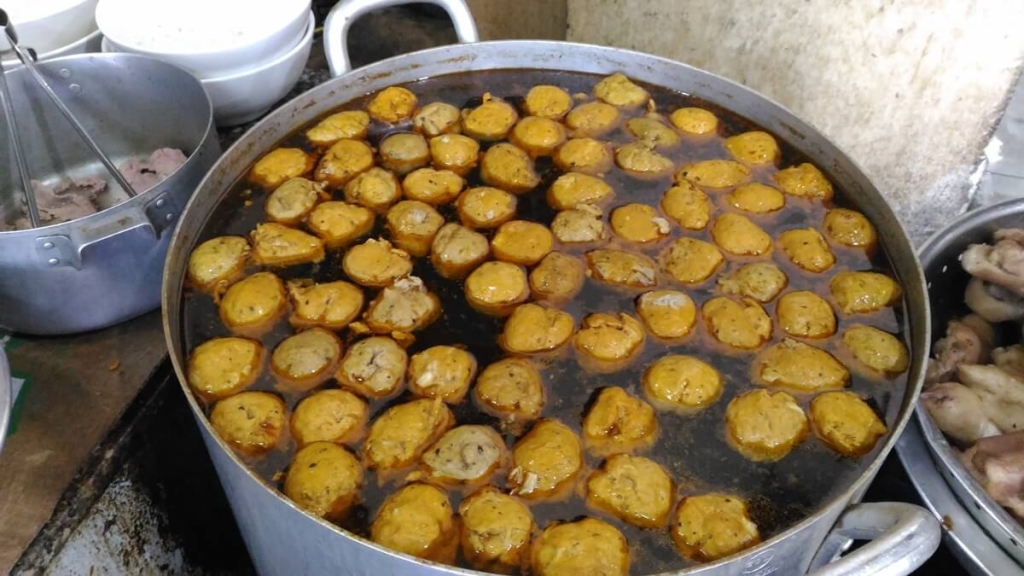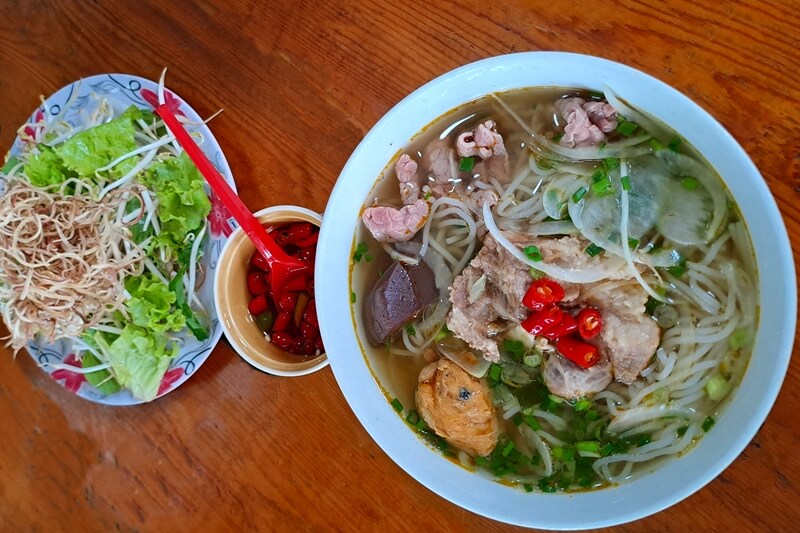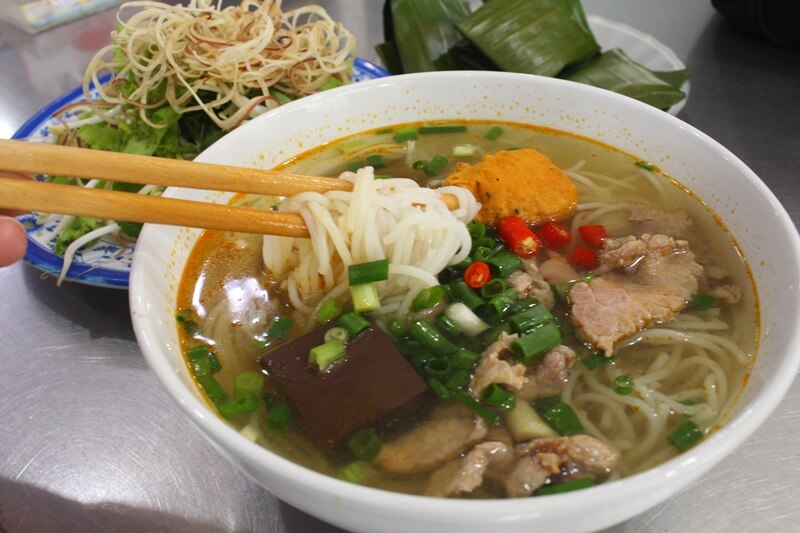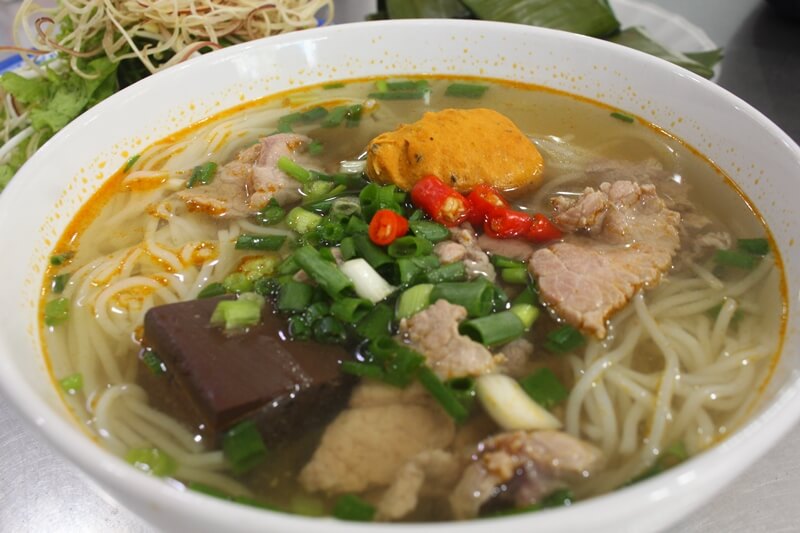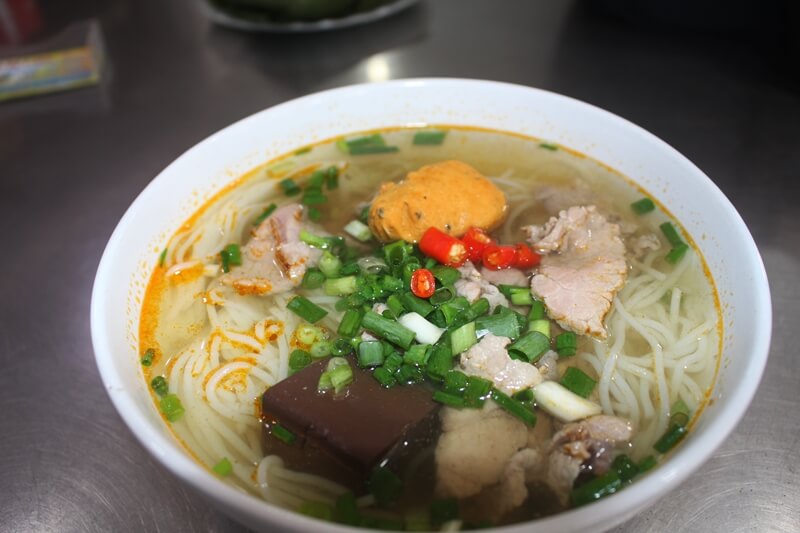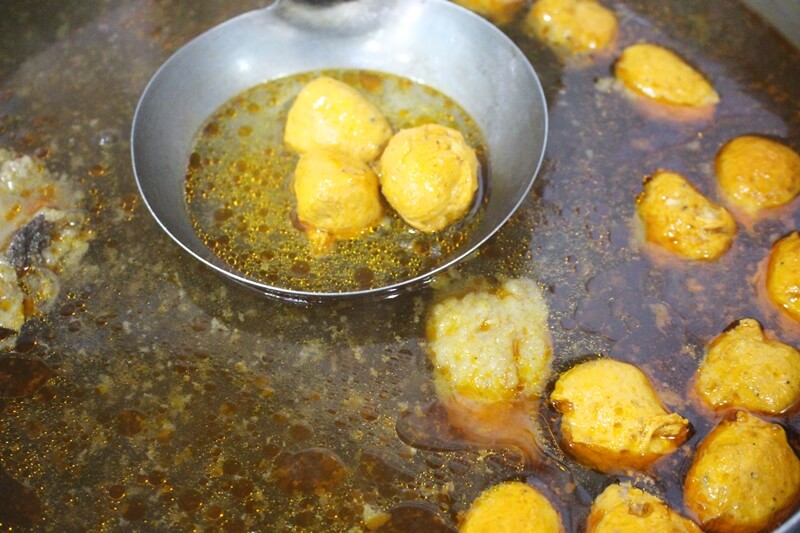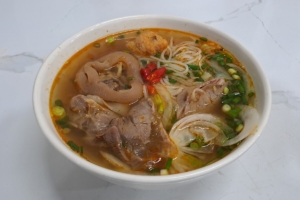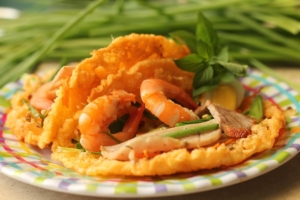Bun Bo Hue, also called Hue beef noodle soup, is one of the tasty local dishes with the unique flavor of the ancient capital of Hue City. The appeal of this dish has been confirmed by its presence in all provinces and cities in Vietnam.
Not only that, many tourists also think that if they have not eaten Hue beef noodle soup, they have not tasted the delicious taste of Vietnamese food yet. And if you want to fully feel the appeal of a bowl of beef noodle soup, you definitely need to go to Hue City – the origin of Bun Bo Hue.
The secret to having quality bowls of Hue beef noodle soup applies to the pot of broth.
The cook must choose the freshest beef bones and stew them for many hours to get a broth rich in protein and sweetness. Once the standard broth is available, the chef continues to combine it carefully with various selected ingredients, including pork leg, meat pie (Cha), fresh crab cakes, onions, lemongrass, pineapple, flavorful spices, fish sauce, and a few spoons of shrimp paste.
However, many chefs specializing in beef noodle soup affirm that the key to making Hue beef noodle soup the best lies in the water source used to cook the broth. Only using clean water taken from the upper reaches of the Perfume River to cook, which can make beef noodle soup have a unique harmonious flavor.
Although the above explanation has not been given by any scientific evidence as a basis for confirmation, with the local experience, the beef noodle soup cooked with Huong River water always offers diners the most specifical taste.
Besides the broth, vermicelli noodles are one of the vital ingredients in creating a unique feature for this food.
The vermicelli noodles here are not too big like those in the North, nor too small like those in the South, but are moderately long and round and much chewier.
The secret is revealed that the flour used to make vermicelli noodles must be rice flour mixed with tapioca flour in a correct ratio, but each vermicelli-making facility has its secret ratio.
At the same time, the dough needs to be kneaded by hand extremely carefully and meticulously. Thanks to that, the noodles are white and soft but chewy and not easily broken.
When serving, people put vermicelli noodles in a bowl and add fatty pork rolls, fragrant crab rolls, a few slices of soft stewed beef, and medium-rare beef meat. Then, pour broth over the noodles. Finally, sprinkle some spring onions and chopped fresh coriander on top of the bowl to increase the color and aroma.
Hue beef noodle soup is always served with a plate of raw vegetables, a few slices of fresh lemon, hot red chili, and especially a cup of shrimp paste.
Hue natives, every time they eat, always want to add a little shrimp paste to increase the strong flavor of the noodle bowl. However, for visitors who taste shrimp paste for the first time, this becomes a “fishy-smelling experience”. It’s a challenge more than a culinary enjoyment. Therefore, remember not to try shrimp paste on your Bun Bo if you have never been familiar with it.
Note: if you come to Hue City and want to taste beef noodle soup, visit restaurants serving tourists. Do not go to small sidewalk shops that specialize in serving local customers. This note ensures food safety for you.
At the same time, at restaurants focusing on local people, the noodle dish will be heavy with shrimp paste and spicy chili flavor, making it difficult to taste. Meanwhile, in restaurants serving tourists, the cook will regulate the amount of shrimp and chili to satisfy the majority of tourists who are tasting Hue vermicelli for the first time.
Origin of Hue beef noodle dish
According to many documents, Bun Bo Hue appeared around the 16th century under Lord Nguyen Hoang. Nowadays, many Hue people still tell each other by word of mouth the story of the “Nàng Bún” (Vermicelli Girl) in Co Thap village, Huong Dien district.
The Nàng Bún was a beautiful, intelligent, skillful girl, making the locals love her so much. She took white rice grains to soak, grind, knead, and squeeze to create delicious, unique noodles.
Her talent and attraction from the dishes she creates make many ugly people jealous. She was kicked out of the village because of the bad people’s slander and distortions. That girl still stubbornly brought her noodle-making profession to the land of Van Cu village (in Huong Toan commune, Huong Tra town). Here, her noodle-making profession was well received by the villagers and quickly developed throughout all of this region.
Not only did she make vermicelli noodles, but she also used beef combined with shrimp paste, hot chili, and spices in the garden to cook the flavorful broth. This broth has created a tasty dish that is hard for anyone to refuse when combined with white vermicelli.
To commemorate the gratitude of the girl who made this delicious and novel dish, people named “Bún” (her name) to name this food. That is the origin of today’s Hue beef noodle dish.
Compare Bun Bo Hue and Pho
In Vietnam, there is a dish that many diners compare with Hue beef noodle soup, that is Pho.
Pho and Hue beef noodle soup have many similarities because they are essentially soup dishes with the main ingredients: fibers made from rice flour, meat added on top, and filled with broth. Also, Bun Bo and Pho (Pho Saigon) are served with raw vegetables.
However, these are still two completely different dishes. The first difference that is most easily seen lies in the shape of the noodle fibers: Pho noodles have a thin and flat appearance, but vermicelli noodles are round and small.
The Pho broth is clear with a sweet taste in Pho Saigon and usually has little or no layer of oil on top. On the contrary, the broth used for the Hue beef noodle dish is rich. The soup color stands out with a shimmering oil layer of intense red chili mixed with the color of annatto seeds, making it look extremely eye-catching.
In particular, only in a bowl of Hue beef noodle soup can diners feel the flavors of lemongrass mixed with the fragrant shrimp paste, awakening all the senses most naturally.
The types of meat used in these two dishes are also different. You can see that the vermicelli bowl is full of stewed beef, rare beef, pork leg meat, and crab rolls. But, a Pho bowl usually only includes beef or chicken. It is almost rare to see pork or a mixture of many types of meats: beef – chicken – and pork in the same Pho dish.
Vegetables served with Pho Saigon usually include basil, coriander, perilla, bean sprouts, garlic, and sweet and sour pickled carrots. The vegetables of Hue beef noodle soup are always mixed raw vegetables, of which thinly sliced banana flowers, various herbs, fresh bean sprouts, and lettuce are indispensable.
When eating, diners will realize that the flavors of Pho and Bun Bo Hue are different. However, depending on each person’s feelings, they think that Bun Bo Hue or Pho has a higher score for deliciousness. With the writer’s feelings, I chose Bun Bo Hue (Hue beef noodle soup), the dish that captured my heart when talking about Vietnamese food.
How to cook Hue beef noodle soup
It is not difficult to cook a pot of Bun Bo Hue right in your family kitchen.
Try this beef noodle soup recipe that Vietnamdrive introduces below.
This recipe is suitable for 4 or 5 diners.
Ingredients:
– 1kg beef bones
– 300gr beef
– 1kg pork leg (you can choose more lean or skin of the pork legs, depending on your preferences and culinary habits)
– 200-gram crab cakes (you can omit this ingredient if you can’t find it)
– 5-7 lemongrass plants, ½ fresh pineapple, 1-2 onions, 1 medium branch of fresh ginger, chili, fish sauce, and common spices (sugar, seasoning powder, pepper).
– ½ spoon of annatto seeds’ oil or powder (omit if you don’t want)
– 2 spoons of shrimp paste. This special spice contributes to the unique original flavor of Hue beef noodle soup. However, it really smells fishy. If you have never tried it, consider it twice before using it. We recommend skipping this ingredient or using it in small amounts and seasoning slowly to ensure it doesn’t ruin your dish.
– Raw vegetables served with lettuce, thinly sliced banana flowers, bean sprouts, herbs, and coriander.
– 1kg vermicelli noodles
8 steps to cook Bun Bo Hue:
Step 1: Washing the meat and bone
Wash beef bones, beef, and pork legs with diluted salt water. Next, chop the beef bones into pieces of moderate size. Cut pork legs into 4-5 pieces. You can choose pork legs or already-cut beef bones available at the supermarket for saving time and convenience.
Step 2: Cook the beef
Put beef bones and large pieces of beef lean into the pot with a few crushed lemongrass stalks, one medium-sized fresh ginger (peeled and crushed), and 1/2 peeled fresh pineapple. Add water to cover the bones and meat and boil over high heat. When the water boils evenly, you skim off the foam that rises to the top. Lower the heat so the water simmers for 45-60 minutes.
Step 3: Cook the pork well
The pork leg is also stewed until soft with lemongrass and a little salt and seasoning.
Step 4: Slide the beef
When the beef lean (in step 2) is soft, take it out, let it cool, and cut it into thin slices to taste.
Step 5: Stir spices and cook the broth
Use a new pot to fry lemongrass, chili, and annatto seeds’ nut/powder with cooking oil. Next, add all the beef bone broth. Add to the pot 1-2 cleaned onions. Dilute the shrimp paste with a cup of filtered water and put it in the pot (option). Wait for the water to boil again, then season it according to your family’s taste with fish sauce, sugar, pepper, and seasoning powder.
Step 6: Mix all meat
Add all the sliced beef (in Step 4) and soft stewed pork leg (in Step 3) to the broth pot. When everything boils well again, use a spoon to scoop out small pieces of crab cake, almost the size of a walnut, and add them to the boiling broth. The crab cakes will be cooked well for about 3-5 minutes after the water boils. Check it for the last time to make sure the soup is just right.
Step 7: Add color to the soup
You can add a little oil of annatto seeds on top of the soup to increase the attractive color. This step is optional, depending on your taste.
Step 8: Serve Bun Bo Hue
After completing the broth, put the right amount of vermicelli in the bowls, pick up the beef, crab rolls, and pork legs, and arrange them on top of the vermicelli. Pour the broth to cover the noodles, then sprinkle on some chopped spring onions.
A bowl of Hue beef noodle soup on the table is served with a plate of raw vegetables, a few pieces of lemon, chili, and a cup of fish sauce. So, you’ve finished the Hue beef noodle dish right in your kitchen.
Enjoy it with your loved ones and feel the unique flavor. This food promises to be an attractive meal for all family members.
Note and required quality of the broth:
The broth to eat vermicelli tastes a little saltier than regular soup, but it needs to be lighter than braised or stir-fried dishes. This salty taste will be balanced when we combine it with noodles and raw vegetables. Therefore, you balance the soup so that a vermicelli bowl is not salty or bland.
A standard bowl of Bun Bo Hue has a rich broth, serving as the perfect bridge for the ingredients, from meat to vermicelli, to blend together to create a unified and flavorful whole.
The pieces of pork and beef must be cooked tenderly. Also, when a person bites them, that diner can feel their original taste but still find the scent of lemongrass and onions inside each peace. In particular, the pork leg still has a blend of beef flavor and vice versa, making the dish extremely tasty.

